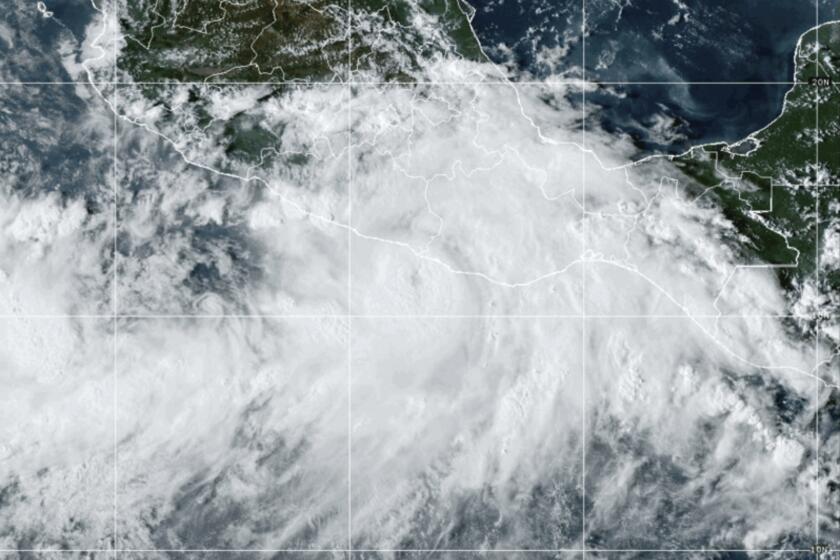Some Inmates Reject Tsunami-Won Liberty
For the 413 inmates of the prison here, Dec. 26 dawned like any other day. Many were let out of their cells at 6 a.m. for exercise and spent several hours milling about the common area. Those housed in cellblocks A and H -- who’d been convicted of murder, rape, making bombs, possessing illegal weapons and other serious crimes -- remained in their cells, in keeping with procedures.
From the prisoners’ perspective, something miraculous then happened. A wall of water slammed into the building, knocking down one of the 15-foot walls and setting all the inmates free.
“It was as though nature made bail for everyone,” said jailer Indika Lasath Kumara, 20, a 6-foot-2 former high school basketball star who was wrapping up his 48-hour shift when the deadly tsunami hit.
Something almost as amazing has happened since then. Eighty-three of those who escaped have returned, knocking on the front door and asking to be taken back to their cells. The first inmates reappeared on the 26th, and more have been trickling in since.
Because the prison is no longer secure and both of its buses were damaged by the storm, officials asked the returnees to take the public bus down the road to another jail, and most complied.
None of the returnees are serious criminals; all have relatively short sentences remaining and would rather serve them out and clear their names than face a life on the run, said the head warden, Chandrasiri Karunasekara.
Most of those who returned did so after checking how their families fared in the disaster and dealing with funeral arrangements, guards said.
The government hasn’t given up hope that more will decide to come back and is offering an amnesty period until Sunday.
But the government isn’t going to wait forever, guards said, adding that the identities of all those still missing have been transmitted to the head office in Colombo, Sri Lanka’s capital.
Still, there is no exact count of how many inmates died in the tsunami and how many are just on the lam.
Meanwhile, reconstruction of the prison has begun.
A fence has been erected where the wall was knocked down. Twenty-eight prisoners have been transferred back to Matara to help with maintenance and reconstruction.
As Karunasekara spoke, 16 inmates in white shorts and undershirts rounded a corner and headed back through the main gate after a rebuilding shift.
With its tall, thick walls and wrought-iron gates, the prison, built by the British 75 years ago, has a colonial feel. A jail of one sort or another has been on the site since the 1700s, shortly after the Dutch arrived on the island. It is located next to a densely packed community of small lanes and two-story houses, on a peninsula between the Nilwala River and the sea. Neighbors say they don’t fear the convicts.
“The prisoners all helped us, so we’re not afraid,” said Manori Kulasooriya, 37, a teacher who lives a few doors down.
“They helped the whole neighborhood, carried babies through the flood and helped people get on roofs.”
A. G. Karunadasa, a 77-year-old man who lives near the facility, agreed.
“The way the water came in, the people in jail were affected first,” he said, his 28-year-old daughter beside him. “Even as they ran away, however, they stopped to help us.”
Guards said that some prisoners, before fleeing, saved the lives of three female jailers who were close to drowning.
Kumara, the guard, had just finished showering around 9:20 a.m. and was dressing when he heard cries that water was coming. He went to investigate and was quickly engulfed by a 12-foot wave. Eight inmates who were sweeping the lane outside the prison as part of work duty were crushed to death by the water.
A couple of guards were under a mango tree behind the jail. They climbed onto a prison bus parked along the river, and Kumara joined them. The vehicle bobbed around in the swirling water. From their vantage point, they noticed a colleague had fallen into the current. Kumara said he lashed himself to a telephone wire, jumped into the water and helped his colleague back to safety.
On Sunday, two Leyland buses lay in disrepair behind the prison, one against the wall with pieces of a guard uniform still visible on the roof, the other wedged beside a small generator building.
At the main entrance, several bales of shiny new barbed wire sat on the floor. Nearby, old sagging foam mattresses were draped over two giant wooden chests that looked like something out of “Treasure Island.” All records in the prison were destroyed by the flood, but jailers were able to recover the weapons from the armory.
Kumara said that as he stood atop the bus, he looked back and saw 70 convicts perched in a tree like birds. “No matter how tough you are, you’re still afraid of death.”
He watched hundreds of people float by, screaming for help. The scene was so horrific, he said, that he has trouble sleeping and still doesn’t have much of an appetite.
The Matara facility, part of a network of 22 prison districts across Sri Lanka, has received four awards in recent years for its humane treatment and approach, and jailers said they expect to be cleared by any official investigation into the escapes, given that they closely followed all procedures.
“We’ve done our best,” Kumara said, holding a Chicago Bulls cap. “We don’t think there will be any problem.”
More to Read
Sign up for Essential California
The most important California stories and recommendations in your inbox every morning.
You may occasionally receive promotional content from the Los Angeles Times.










